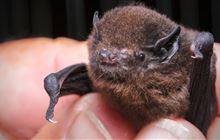Rare native bats at home in remote township
Archived content: This media release was accurate on the date of publication.
Introduction
Bat detectors placed in the Central North Island township of Owhango during June have revealed long-tailed bat (pekapeka-tou-roa) activity on all four detectors placed.Date: 14 September 2021
This discovery has excited local conservation groups and DOC rangers alike, as long-tailed bats are a critically endangered native species endemic to New Zealand.
Bats go into a kind of hibernation called torpor during winter to conserve energy, so it was a welcome surprise to the team to have recorded so many bat passes during this time.
There was heavy rain and wind on many nights over the course of monitoring, which can also deter long-tailed bats from foraging.
DOC Biodiversity Ranger Luke Easton placed the detectors that revealed the bats’ presence.
“Ohinetonga Scenic Reserve is clearly a foraging area (where the bats congregate to feed) given the high amount of activity and ‘feeding buzz’ calls recorded.
“It is very promising to have found bats in the reserve; the pest control efforts that Owhango Alive (a community group which maintains traplines in the reserve) have carried out in the area will be contributing towards the protection of local populations of bats.
“We thank Owhango Alive for their continued commitment to the area and the work they are putting in to make sure fauna and flora are thriving in the reserve.”
The recorders also picked up squeaking noises from rats – a solemn reminder that even though numbers of stoats and rats are controlled in the reserve by trapping, there is still much more work to be done. Rats are one of the many predators of long-tailed bats -which also fall prey to cats, stoats and weasels.
While predation is the major factor for declining bat numbers, they are also affected by habitat loss – long-tailed bats have very particular requirements for choosing trees to roost in; in summer they move into a different roost tree most days, so require a number of suitable trees to rotate amongst.
Long-tailed bats tend to favour trees over 100 years old, and they tend to come back to these same trees year after year. When roost trees have been felled to make way for construction or infrastructure, local bat populations suffer declines.
Sally Lashmar from Owhango Alive was pleased to have the presence of long-tailed bats confirmed as there had been many suspected sightings by locals over the years.
"Owhango Alive is stoked that we now have evidence of long-tailed bats in the Ohinetonga Scenic Reserve and the village of Owhango.
“Residents have mentioned a few times that they thought they'd seen bats at dusk, so to now have recordings of them, in four different locations, is very exciting. We plan to hold a "spot the bat" evening in the summer. We would like to thank DOC staff for pushing this to happen."
A mix of factors can make for good habitat for long-tailed bats to thrive. The first is mature trees that have the ideal characteristics for bats to roost in, the second is good feeding grounds in terms of numbers and varieties of insects that bats feed on, and the third is good quality pest control.
DOC Principal Ecosystems Science Advisor Colin O’Donnell has been studying long-tailed bats in the Eglinton Valley in Fiordland since monitoring began 25 years ago, and has seen bat numbers in some colonies more than triple over the term of 15 years of aerial 1080 predator control. The long-tailed bat population in the Eglinton Valley was declining at a rate of 5% per year when monitoring began – now the population is increasing by 4% per year.
“With a mix of pest control methods, including both ground based and aerial pest control, we can really make a difference for populations of critically endangered native species like the long-tailed bat.
“Evidence shows that population numbers greatly improve in areas where we have used targeted pest control, and these efforts are what will keep long-tailed bats from going extinct in the medium to long term.”
Contact
For media enquiries contact:
Email: media@doc.govt.nz

